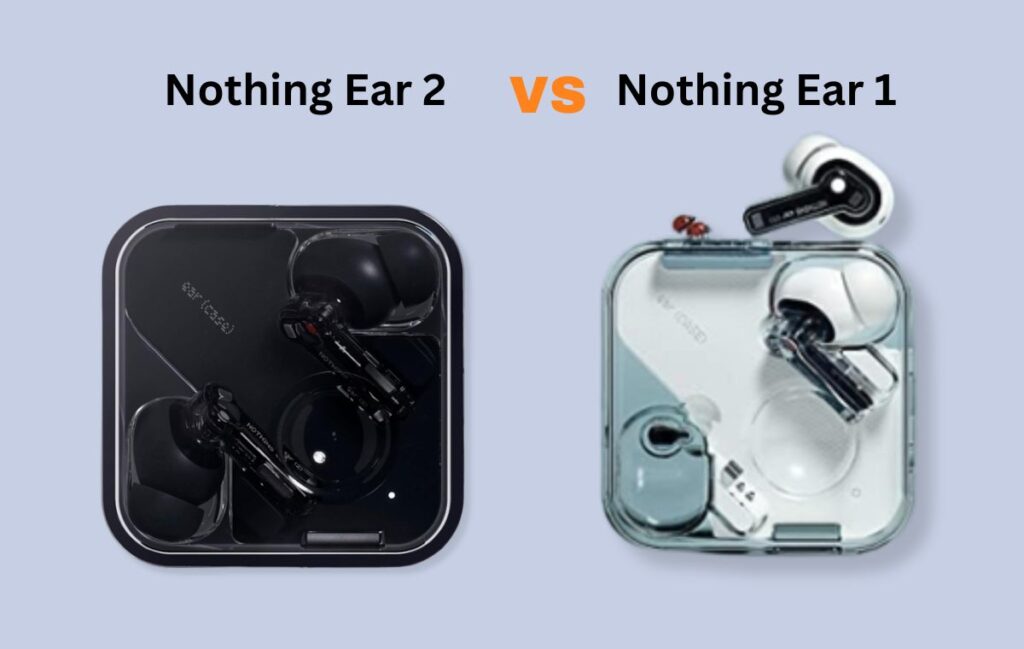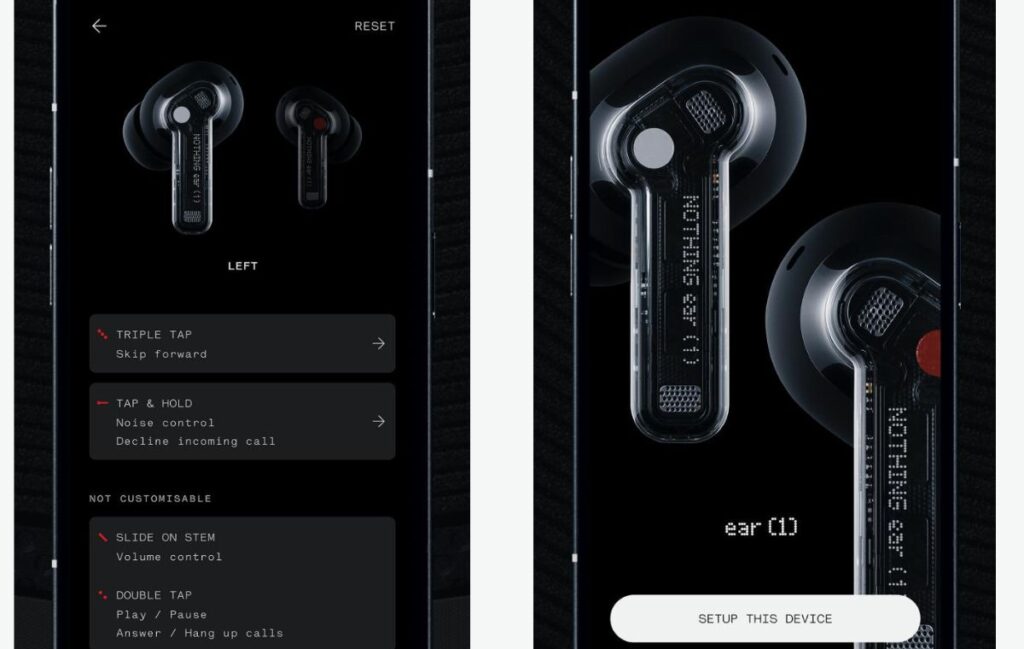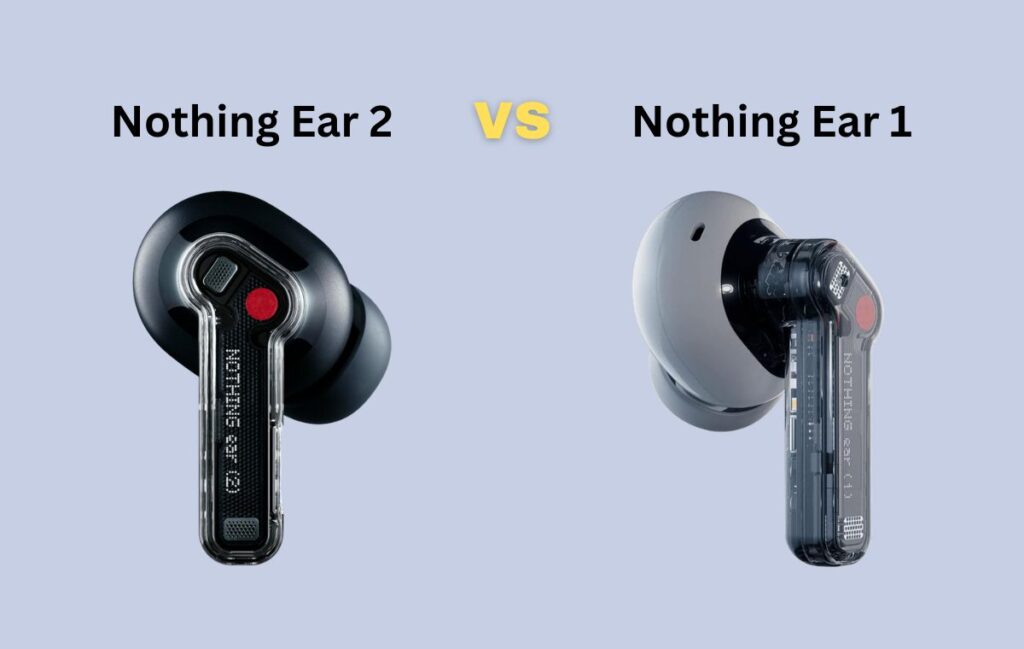We’re going to compare side by side with the original Ear Ones to see what’s changed and also how the A2s compete in this now saturated market of great earbud options.
Note: This article contains Amazon affiliate links. If you make a purchase through these links, I may earn a commission at no extra cost to you.
Unboxing and Charging Case

Nothing’s Ear 2 is an iteration of what came before, with mostly internal spec bumps. So, you can expect a similar experience from the outside, and that includes the unboxing. We get the usual paperwork, of course, the charging case, and the earbuds themselves, with small and large ear tips (the mediums are already attached). Finally, there’s a short but braided USB-C cable, which is better than the usual cheap ones you get.

The charging case follows a similar design to the previous Ear 1, with the obvious difference being that it’s now much smaller and easier to fit into your pocket, which is great. There’s also a new, tougher material added to both the inside and outside for added structural integrity and grip. I really like this case, and, of course, a huge part of that is how cool it looks. It’s one of Nothing’s main and genuinely great selling points. The White Version shows off the earbuds more clearly, but I personally love the new all-black aesthetic.
They’ve made sure to keep the cases functional as well, not only in their pocket-friendly size, but the earbuds are easy to access, the magnets work well, and they support convenient wireless charging too. There’s even an IP55 rating for the case itself. Companies usually neglect the case for water and dust protection, and I think the pairing of Nothing’s earbuds with their phones makes for the best-looking earbuds and phone combo on the market right now.
Read Also: Samsung Galaxy Buds 2 Pro vs Pixel Buds Pro Comparison
Design and Comfort

With the earbuds themselves, there’s even less of a design change. The Nothing Ear 2 is marginally taller, though it could easily be mistaken for the first gen, but that’s really not a bad thing. We still get that gorgeous transparent build that shows off all the internals, and once again, Nothing deserves to be commended for pulling off this difficult feat.
This is how the earbuds look in the ear versus both the White Version and the previous year one, so these remain small and relatively discreet earbuds. They offer really great comfort too, thanks to being so lightweight and providing a reasonably secure fit. I can just about run with these, but they’re not super secure, so for me, they don’t make the best workout option. However, you probably could get away with using these for that as well.
Nothing slightly increased the durability by adding some dust protection, but the IP54 rating means these will only ensure light splashes and still can’t be submerged underwater.
Active Noise Cancellation
Now, because the seal in the ear is quite gentle, even with the large ear tips, they’re comfortable. But the passive noise isolation isn’t the best, and this, in turn, affects the ANC (Active Noise Cancellation) performance. I actually described the Year One’s ANC as good when I reviewed those. But given how much earbuds have massively improved since then, it’s actually relatively poor now, and the Year 2 does little to improve on that. The cancellation focuses mostly on the low-end frequencies but still only gives a subtle noise reduction compared to the off mode.
You do at least now get an Adaptive ANC mode as well as a personalized option, which is supposed to be tailored to your ear shape. But I honestly couldn’t hear much of a difference with this. At the very least, I wouldn’t describe this as better than the other modes. So overall, these are only average noise cancellers at best. I’d love to say it was great for the price, but Soundcore Liberty 4 recently came along and blew that idea out of the water with phenomenal ANC performance for well under a hundred dollars. So perhaps just set your ANC expectations low.
One saving grace could be the transparency mode, which does a good job of naturally amplifying your surroundings. There is a faint hiss, but the pass-through, in general, works really well and allows you to clearly hear what’s going on around you.
Touch Controls

Also included in the app is some customization for the controls. You don’t get complete freedom to remap each gesture, but there’s still a decent range to personalize. Notice how these are labeled for pinch gestures. The E2 swaps out the typical touch surface for a squeeze gesture on the stem, similar to AirPods Pro. I guess Nothing is still focused on making the Apple of Android.
I think this control change will be hit or miss. Some will prefer the extra precision you can get with the squeeze; this can often be more reliable. However, you now lose the popular swipe for volume gesture on the stem, which actually works really well on A1. You can swap something to include volume control, but it’s just not as intuitive with the squeeze gesture, so I personally prefer the older style controls.
On the plus side, Nothing has kept wear detection and has tried to keep a good range of gestures by including a double pinch and hold command, which you don’t often see.
Nothing Audio App Extra Features

In the nothing audio app, we have toggles for in-ear detection, low lag mode, and find my earbuds – those will return from the Ear Ones. The new features include an ear tip fit test, personalized ANC (as I mentioned earlier), toggles for dual connection or multi-point, and finally, an option for high-quality audio that enables the LHDC codec. So, the app now offers a more well-rounded feature set.
Connectivity
Connectivity is one of the areas that has been nicely improved. We get the latest Bluetooth 5.3 spec, up from 5.2. The addition of multi-point is excellent, allowing us to connect to two devices at the same time. The new codec means the earbuds now offer 24-bit high-res audio. The downside is that not many devices support it. It’s not like Sony’s LDAC, where basically all Android phones have it. It’s mostly Chinese brands like Oppo and Xiaomi. If you have popular phones like Samsung’s, Google Pixels, or iPhones, of course, you won’t be able to get high-res audio. If you have a Nothing phone, these do support it, but I’m sure that’s just a complete coincidence and not an attempt to keep you in their ecosystem. Wow, I guess Nothing is well on their way to becoming the Apple of Androids.
These earbuds aren’t exactly the market leaders for sound quality, so it doesn’t matter too much if you can’t use this codec. I don’t think the audio files were considering these anyway. We still get Google Fast Pair for quick and easy setup, Microsoft Swift Pair for Windows PCs and laptops, and there are no latency issues with videos. For gaming, these are okay, and that low-lag mode helps a lot, but it’s not perfect, and there are better earbuds for fast-paced gaming if that’s your thing.
Battery Life
Now, one spec that sadly didn’t get a big upgrade is the battery life. At just five hours, the Year One earbuds are clearly on the low side for earbuds, and the Ear 2 only increases this to 6 hours, provided you’re not using ANC. If you do use ANC, then it drops down to a measly four hours. I definitely noticed these running out a lot sooner than most of the earbuds I use. If you’ll charge often and only need to listen for short periods, then this may be no issue. Additionally, you still get fast charging and wireless charging to make things more convenient.
Mic Quality
There’s also some loud background noise, like passing traffic, but these earbuds are doing a good job of isolating my voice. Some of you might remember when we first reviewed these; we said they were already a pretty good option for phone calls. Now, you’re listening to Nothing’s Ear 2, and hopefully, you can hear there is a subtle improvement in the microphone quality. I actually thought these were an excellent option for phone calls, and I think they’ve made it into my top five in the category of microphone quality among all earbuds.
Sound Quality

All right, let’s talk about sound quality now. On paper, these appear to offer the same 11.6-millimeter drivers as before, but a new dual-chamber design improves airflow to give brighter and clearer audio – that’s what Nothing claims anyway. But to be fair, comparing side by side with the A1, you can hear this. I was more pleased with the bass improvement; there’s generally more weight in the low end, which was lacking slightly before, even if the bass doesn’t thump or boom in the way bass heads might enjoy.
Straight out of the box, the sound is clear and pretty well balanced. I certainly didn’t find the highs to be piercing, as some early reviews noted. But then again, these have since received some software updates to improve this. Speaking of which, the launch of the black color for Ear 2 came alongside the new Advanced EQ. Previously, we had this simple three-band custom EQ, but it was rather limited. Now, you have eight bands to play around with, plus you can fine-tune the specific frequency and Q factor as well. So, this can be pretty complicated and goes far beyond what an average consumer will want to use. But I guess we can’t really complain about customizing the sound.
Now, there’s a new personalized sound feature as well, which tests your hearing and produces a tailored equalizer according to your results. The test is a bit more tricky to complete than some other earbuds, but the result did give me a slight improvement over the default tuning. Once you’re done, you’re able to adjust the intensity of this new sound profile, and it did further enhance the clarity for me.
One flaw I’ve noticed with these, though, is that there’s a big EQ shift when switching to the off listening mode. ANC and transparency mode sound good and the same, but when I go to off mode, the bass drops considerably, and the mid-range sounds hollow and unrefined. This is really disappointing, not just because of the lack of consistency but also because the ANC isn’t that great with these, and I’d normally prefer to listen in off mode to save on battery. So, I really hope this is fixed with an update soon.
Are these one of the market leaders for sound quality? No. But EQ shift aside, I think it’s more than good enough for the average listener and a nice step up from the first-gen Nothing earbuds as well.
Which One Should You Buy?
I think, in general, Nothing Ear 2 earbuds are a nice step up from the original Ear One, even if the improvements aren’t groundbreaking. For that, you’ll need to spend $149. Although that’s a $50 increase, Nothing did raise the price of the V1 to this amount anyway. I still think the design is the best reason to get these earbuds, and therefore, it’s going to be hard to tempt Ear 1 owners to upgrade. But for those of you looking at both, there are compelling reasons to get the new Ear 2 instead: the addition of multi-point, the improved sound on calls, and the extra customization options.
The competition is strong, though, and to be frank, there are better options in pretty much every category, most notably for the noise cancellation, which isn’t great here. The thing is, though, that this industry moves on at lightning speed. There’s always going to be a better pair of earbuds, each of them with their own individual trends, and each person has different priorities for these. The Ear 2’s strength just happens to be this awesome design. But it’s not as though the rest of the specs and features aren’t pretty solid too.
So, if you want to get these purely because they look awesome, I’d say go for it. They don’t exactly cost a fortune; it’s pretty reasonable for what you get. And if you end up finding an aspect lacking, then you’ve just identified what you can look for in your next pair of earbuds. So, what do you think? Has Nothing done enough to convince you to finally pull the trigger on these?




